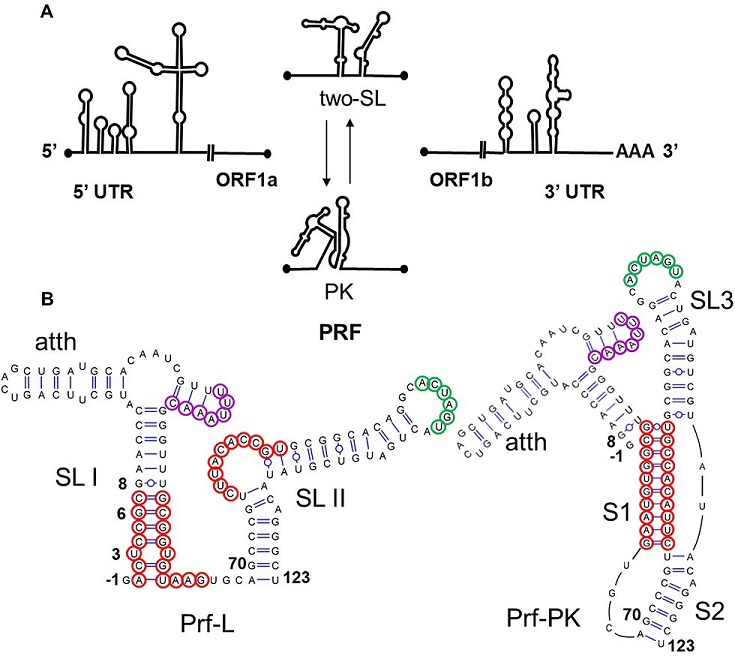COVID-19 News-new-insights-into-ribosomal-frameshifting-mechanisms-of-coronaviruses-including-SARS-CoV-2
Nikhil Prasad Fact checked by:Thailand Medical News Team Aug 21, 2024 1 year, 2 months, 4 weeks, 8 hours, 4 minutes ago
COVID-19 News: Researchers from Spain and the USA have made significant strides in understanding the ribosomal frameshifting mechanism of SARS-CoV-2, the virus responsible for COVID-19. The study was conducted by a team from the Centro de Investigación Traslacional San Alberto Magno, Universidad Católica de Valencia in Spain, and the Icahn School of Medicine at Mount Sinai in New York, USA. This
COVID-19 News report delves into their findings, which could pave the way for new antiviral drug developments.
 New insights into ribosomal frameshifting mechanisms of coronaviruses including SARS-CoV-2
SARS-CoV-2 genomic RNA and PRF domain. (A) Schematic representation of the SARS-CoV-2 genome and the PRF element governing translation of ORF1b proteins, depicted in the two-SL and PK conformations. (B) RNA sequences analyzed in this study, together with their predicted secondary structures: Prf-L (123-nt full-length PRF), Prf-PK (116-nt PRF domain with seven nt removed from the 5′-end of SL I), SL-I (upstream SL I), SL-II (downstream SL II) and Atth (attenuator hairpin present in SL I). The ACUAGU palindrome present in Prf-L, Prf-PK and SL-II and responsible for Mg2+-dependent homodimerization is marked in green. Slippery site bases are circled in magenta. The nt involved in the proposed base-pair switch are circled in red in the Prf-L and Prf-PK structures. To obtain genomic numbering add 13 419
What is Ribosomal Frameshifting?
New insights into ribosomal frameshifting mechanisms of coronaviruses including SARS-CoV-2
SARS-CoV-2 genomic RNA and PRF domain. (A) Schematic representation of the SARS-CoV-2 genome and the PRF element governing translation of ORF1b proteins, depicted in the two-SL and PK conformations. (B) RNA sequences analyzed in this study, together with their predicted secondary structures: Prf-L (123-nt full-length PRF), Prf-PK (116-nt PRF domain with seven nt removed from the 5′-end of SL I), SL-I (upstream SL I), SL-II (downstream SL II) and Atth (attenuator hairpin present in SL I). The ACUAGU palindrome present in Prf-L, Prf-PK and SL-II and responsible for Mg2+-dependent homodimerization is marked in green. Slippery site bases are circled in magenta. The nt involved in the proposed base-pair switch are circled in red in the Prf-L and Prf-PK structures. To obtain genomic numbering add 13 419
What is Ribosomal Frameshifting?
The programmed ribosomal frameshift (PRF) is a process used by many viruses, including coronaviruses, to produce essential proteins from their RNA genome. This mechanism involves the ribosome - the molecular machine responsible for translating RNA into proteins - slipping by one nucleotide during translation, which changes the reading frame and allows for the production of different proteins from the same RNA sequence. In SARS-CoV-2, this frameshifting is crucial for the virus to synthesize proteins necessary for its replication and survival.
The Importance of the PRF Region in SARS-CoV-2
In SARS-CoV-2, the PRF region is located between two key parts of the virus’s RNA genome, known as ORF1a and ORF1b. This region allows the virus to control the production of proteins that are involved in RNA synthesis and viral replication. The PRF region's ability to shift the ribosome's reading frame is dependent on the formation of a specific RNA structure called a pseudoknot, which has been a focus of this study.
Study Findings: A New Look at the PRF Structure
The study findings highlight that the PRF region of SARS-CoV-2 does not always form the pseudoknot structure that was previously thought to be essential for frameshifting. Instead, researchers found that in the absence of the ribosome, the PRF RNA adopts a different conformation with two stem-loops. This structure seems to be conserved across various coronaviruses, suggesting it plays a vital role in the virus&#
39;s life cycle.
The team used Nuclear Magnetic Resonance (NMR) spectroscopy to analyze a 123-nucleotide sequence of the PRF region from SARS-CoV-2. Their analysis showed that the PRF region forms a two-stem-loop structure in the absence of the ribosome. This structure is distinct from the three-stem pseudoknot that was previously observed in shorter RNA sequences.
Why This Matters: Implications for Antiviral Drug Development
The discovery of this two-stem-loop structure has significant implications for the development of antiviral drugs. The study suggests that the pseudoknot structure may only form transiently during the translation process, specifically when the ribosome disrupts the upstream stem of the two-stem-loop structure. This means that targeting the two-stem-loop structure, rather than the pseudoknot, could be a more effective strategy for inhibiting viral replication.
Moreover, the research indicates that the upstream stem of the PRF region plays a critical role in regulating frameshifting activity. When this stem is intact, the frameshifting activity is reduced, suggesting that disrupting this structure could inhibit the virus's ability to replicate. This finding opens up new avenues for designing drugs that can specifically target this part of the virus's RNA.
Conservation Across Coronaviruses
The study also found that the two-stem-loop structure is conserved among SARS-like coronaviruses. This conservation across different viruses suggests that this structure is essential for the virus's ability to cause disease. Interestingly, the researchers found that even though the pseudoknot structure was not observed in the full-length RNA of SARS-CoV-2, the potential for it to form exists when the upstream stem is disrupted.
Conclusion: A Step Forward in the Fight Against COVID-19
In conclusion, this study provides new insights into the RNA structures involved in the frameshifting mechanism of SARS-CoV-2. The discovery of the conserved two-stem-loop structure and its role in regulating frameshifting opens up new possibilities for antiviral drug development. Targeting this structure could potentially disrupt the virus's ability to replicate, offering a new strategy in the ongoing fight against COVID-19.
The study findings were published in the peer-reviewed journal: Nucleic Acids Research.
https://academic.oup.com/nar/advance-article/doi/10.1093/nar/gkae704/7734159#
For the latest
COVID-19 News, keep on logging to Thailand Medical News.
Read Also:
https://www.thailandmedical.news/news/carrimycin-inhibits-sars-cov-2-replication-by-decreasing-the-efficiency-of-programmed-1-ribosomal-frameshifting
https://www.thailandmedical.news/news/breaking-medical-news-university-of-cambridge-study-shockingly-finds-that-current-mrna-technology-causes-1-ribosomal-frameshifting
